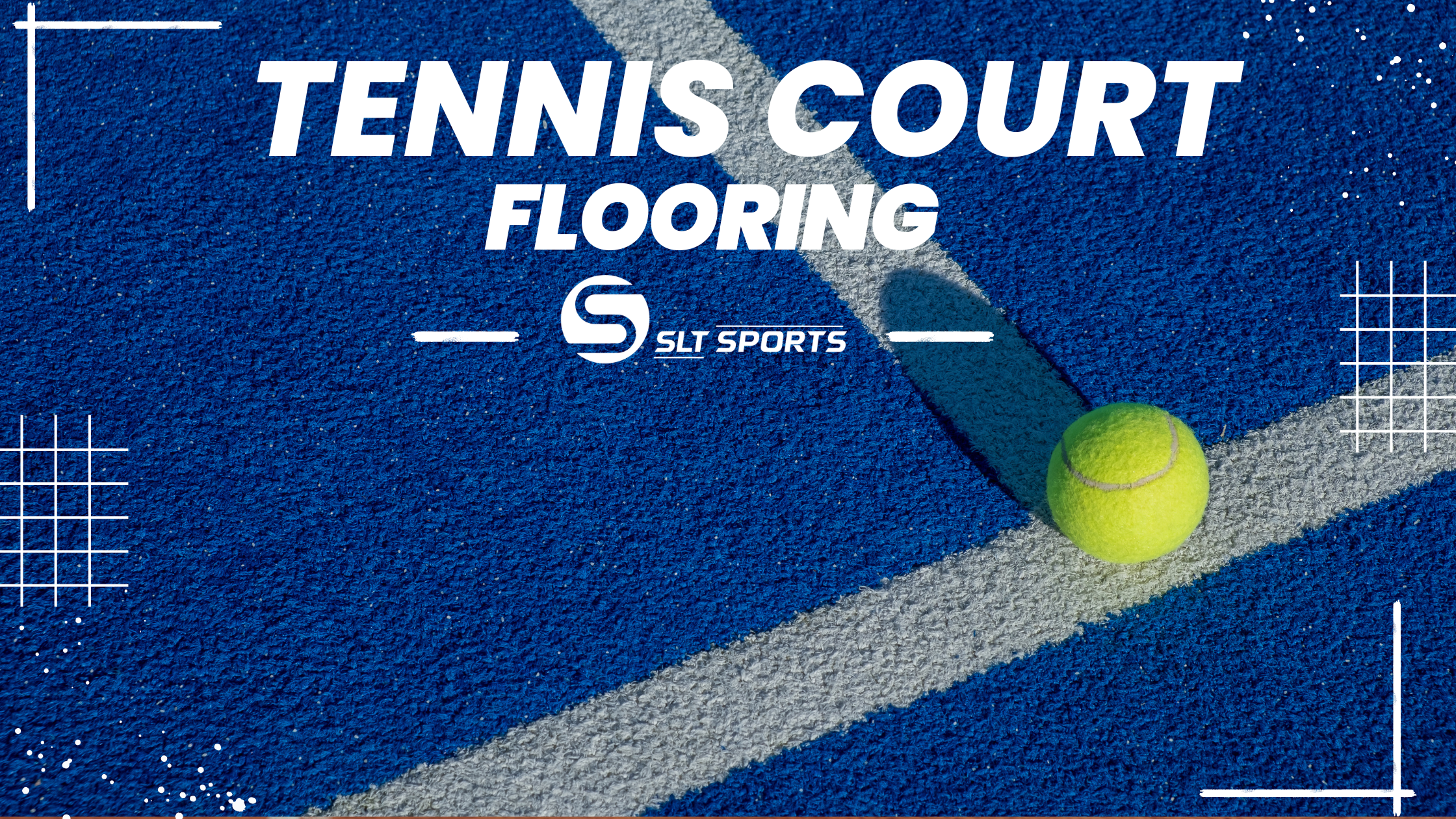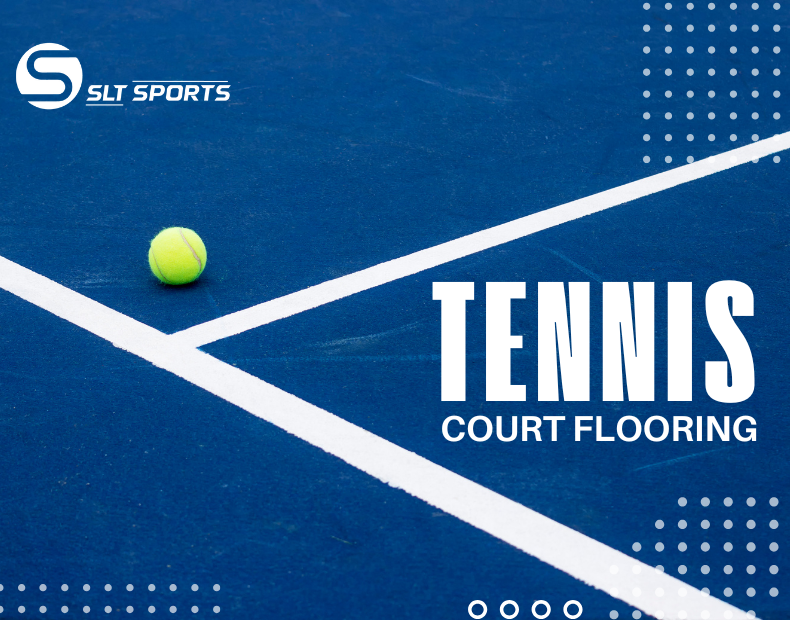
A good tennis court is for both amateur and pro players, a must have. Knowing tennis court dimensions, markings and surfacing is key to building, resurfacing or maintaining a court. Whether you’re looking at tennis court surfacing, tennis court painting or acrylic tennis flooring, knowing the right measurements ensures you comply with international standards. At SLT Sports we specialise in high quality tennis court flooring solutions that are durable and performant and cost effective to maintain.

Tennis Court Measurement According to ITF Standards
The International Tennis Federation (ITF) defines a tennis court as a rectangular area of 23.77 meters (78 feet) long. The width varies depending on the type of play:
- Singles Court Width: 8.23 meters (27 feet)
- Doubles Court Width: 10.97 meters (36 feet)
These standards ensure all tennis courts around the world have the same playing environment. The total surface area of a standard tennis court is approximately 195 square meters (2,106 square feet) for doubles and 195 square meters (1,948 square feet) for singles.
The ITF tennis court specifications also regulates court surfaces to ensure they meet international play standards. They categorise court speeds into 5 classifications—slow, medium-slow, medium, medium-fast and fast—to help determine how surfaces affect play.
Indoor vs. Outdoor Tennis Court Size
Both indoor and outdoor tennis courts have the same size. However, other aspects such as court surface, lighting and environment may influence play. Outdoor courts require tennis court resurfacing and tennis court painting to endure weather changes. Indoor courts are built with controlled environments to minimize wear and tear but could require special lighting and ventilation settings to maximize play.
Tennis Court Markings and Line Dimensions
Every tennis court must follow ITF marking standards for fairness and consistency. Below are the key markings with their dimensions:
- Baseline: The rear of the court where the players serve and return.
- Sidelines: The vertical lines along the court’s length, for singles and doubles play.
- Service Line: 6.40 meters (21 feet) from the net, it’s where a legal serve has to land.
- Center Mark: A small mark at the center of the baseline, to assist players in serves.
All these lines help in fair play and enable players to develop precision in shots and strategy. The ITF demands that all courts have well-defined and precisely measured lines so that play can be consistent across various locations.
The Distinct Sections of the Playing Area
There are specific parts of the playing court, each with a different function:
- The Service Boxes: These are the two rectangular areas formed by the service line and center service line, where a serve must land in order to be counted.
- No-Man’s Land (Midcourt): The area between the baseline and service line, often where players position themselves for volleys.
- Doubles Alleys: Additional areas at the sides of the court existing solely in doubles play.
The areas dictate differing strategies used while playing. As an example, baseline players focus on rallies going deep from their end, and net players utilize quick volleys and drop shots. The ITF regulates tennis court marking and designations of these areas to maintain similarity in professional as well as amateur play.
Tennis Court Flooring and Surfacing Options
The selection of tennis flooring is crucial in performance and durability. Among the most popular of tennis flooring is acrylic tennis flooring due to its ability to withstand weather, durability, and ability to produce the optimal ball bounce. Acrylic flooring is also preferred since it requires low maintenance and suits diverse climates. The other alternatives of flooring are clay, grass, and artificial turf, each of which possesses diverse playing characteristics.
We at SLT Sports are experts in premium acrylic tennis court surfacing, ensuring durability and playability. Our floor solutions provide professional standards, recreational facilities, and private courts, which have made us a recognized brand in the industry.
Types of Tennis Court Flooring
There are several types of tennis court flooring, each of which is appropriate for various needs and circumstances:
- PVC Vinyl Flooring: Indoor courts, with shock absorption, slip resistance, and durability.
- Acrylic Flooring: A favorite for indoor and outdoor courts, with smooth surface and consistent ball bounce, weather resistance, and low maintenance.
- Artificial Turf: Suitable for multi-sport and recreational courts, with a more cushioned playing surface and less joint stress for athletes.
- Sports Interlocking Tiles: Ideal for multi-use or temporary facilities, simple to install and maintain, great drainage for outdoor applications.
The selection of the surface will be based on considerations such as climate, player preference, and maintenance needs. SLT Sports offers professional consultation to assist clients in choosing the perfect solution for their purpose.
Comparison Table – Tennis Court Surface Types
| Surface Type | Ball Speed | Maintenance | Ideal For |
|---|---|---|---|
| Acrylic | Medium-fast | Low | All-weather courts |
| Clay | Slow | High | Pro practice |
| Turf | Medium | Medium | Multi-sport use |
| Vinyl | Medium | Low | Indoor courts |
Tennis Court Resurfacing and Cost
Over time, even the best-built courts need to be maintained. Tennis court resurfacing involves reapplying surface coatings, repainting lines, and filling cracks. Tennis court resurfacing cost depends on a number of factors, which are:
- Current Court Condition: Small cracks and faded lines cost less to repair than major structural damage.
- Surface Type: Different types of maintenance are required for acrylic, clay, and synthetic turf courts.
- Location and Weather: Courts in areas that experience extreme weather conditions may be more in need of resurfacing.
The average tennis court resurfacing cost can range from a few thousand to tens of thousands of dollars, based on the amount of work involved. Maintenance, like timely tennis court painting, can have the court last longer in service and save on future resurfacing expenses.
Tennis Court Maintenance Tips
Maintenance plays a crucial role in the guarantee of the quality of a court. Some guidance on how to maintain for durability is presented below:
- Regular Cleaning: Remove dirt and debris from the surface to prevent damage.
- Checking for Cracks: Fix tiny cracks before costly repairs.
- Painting Dull Lines: Clear lines on the court surface improve gameplay and visibility.
- Drainage Monitoring: Sufficient drainage to prevent water damage and mold formation.
By keeping to these maintenance schedules, owners of courts are able to save in the long term and have their courts in their best condition.
Conclusion
Whether you are installing a brand new court, overlaying an existing one, or simply wondering about the tennis court dimensions & markings and looking after them, SLT Sports is your one-stop-shop. With our knowledge in tennis court flooring, tennis court marking, and acrylic tennis flooring, your court will be playing its best for years to come. We provide high-quality solutions to suit any budget and standard of play.
For world-class professional surfacing of tennis courts and tennis court dimensions & markings, call SLT Sports today. Allow us to help you create a world-class playing experience!
Frequently Asked Questions
Best surface varies with player choice, budget and climate. Acrylic tennis flooring is low maintenance and long lasting, while others vary in playing speed and comfort.
A tennis court needs at least 36.57m x 18.29m (120ft x 60ft) to play safely, with additional space for fencing, seating and lighting. Additional space may be needed for professional courts.
Cost of a tennis court varies with the surface and location. On average it is between ₹20 lakh and ₹1.25 crore, with additional cost for fencing, lighting and maintenance.
There are four types of tennis courts: acrylic court, sports interlocking tiles courts, PVC vinyl Court and artificial turf courts. Each surface has varying playing speeds, maintenance requirements and durability.
It takes 1 to 3 months to construct a tennis court, depending on surface type, weather and permit approvals.

